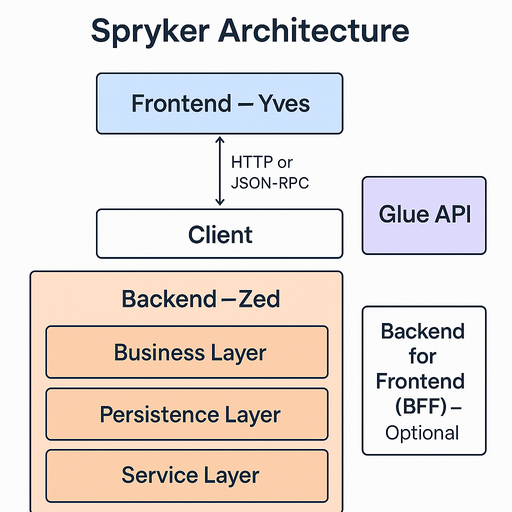Spryker is a powerful, enterprise-level commerce framework known for its modular, flexible, and scalable architecture. It allows businesses to customize their commerce stack easily, making it ideal for complex B2B, B2C, and marketplace solutions.
In this blog, we’ll walk you through the Spryker architecture, layer by layer, and explain how its components interact with each other using a visual diagram.
Why Architecture Matters in E-commerce
A well-structured architecture ensures:
- Faster development and deployment cycles
- Scalable feature additions
- Seamless integration with third-party systems
- Clear separation of concerns (SoC)
- Efficient debugging and testing
Spryker shines in all these aspects thanks to its Layered and Modular Architecture.
Spryker Architecture Overview
Here’s the conceptual diagram to help visualize how Spryker works behind the scenes:
Spryker Architecture Diagram

Layer-wise Breakdown
1. Frontend – Yves
- Role: Presentation layer
- Tech: PHP (Twig), JavaScript, HTML, CSS
- Purpose: Handles rendering views and interacting with the customer.
- Uses: Controllers fetch data from Zed via the Client layer using HTTP or JSON-RPC.
💡 Yves is designed to be headless-friendly and API-ready.
2. Client Layer
- Acts as a bridge between the frontend (Yves) and the backend (Zed)
- Fetches data and caches it locally to improve performance
- Sends requests to Zed via ZedRequest module
3. Backend – Zed
- Zed is where the actual business logic resides.
- Handles complex operations like:
- Cart operations
- Checkout processing
- Product & pricing logic
- User & order management
It contains the following sub-layers:
a. Business Layer
- Contains facades, services, and business rules
- Implements use-cases (e.g., process order, validate product stock)
b. Persistence Layer
- Manages data storage using Propel ORM
- Handles interactions with the database (PostgreSQL, MySQL, etc.)
- Contains entities, repositories, and query containers
c. Service Layer
- Provides reusable logic that can be accessed by both Zed and Yves
- Stateless, decoupled utility layer (e.g., string formatter, currency converter)
4. Glue API Layer
- Optional but highly useful
- Offers REST and GraphQL interfaces
- Used in headless and mobile-first architectures
- Connects third-party apps, frontend frameworks (React, Vue), and PWA
5. Backend for Frontend (BFF) – Optional
- Sometimes implemented for GraphQL or Mobile apps
- Abstracts complex backend logic from frontend apps
Development Tools & Flexibility
Spryker’s architecture supports:
- Modular deployment via Docker and Kubernetes
- Code generation using Spryker SDK
- Marketplace-ready modules
- Atomic module isolation: Every module (e.g., cart, product) can be developed/tested independently
Benefits of Spryker’s Architecture
✅ High customization
✅ Scalable for complex projects
✅ Separation of concerns
✅ Faster development cycles
✅ Efficient team collaboration
Bonus: Spryker Architecture in Microservices Context
Spryker can also be decomposed into microservices using:
- Event-Driven architecture
- RabbitMQ for async communication
- APIs for B2B/B2C channel separation
Final Thoughts
Spryker’s architecture is built for future-facing commerce businesses. Whether you’re building a B2B marketplace, launching a headless storefront, or scaling operations globally, its modular and layered structure empowers you to build fast and scale faster.
Thank you for reading! I hope this deep dive into Spryker’s architecture helps you build smarter, faster, and more scalable commerce solutions.
